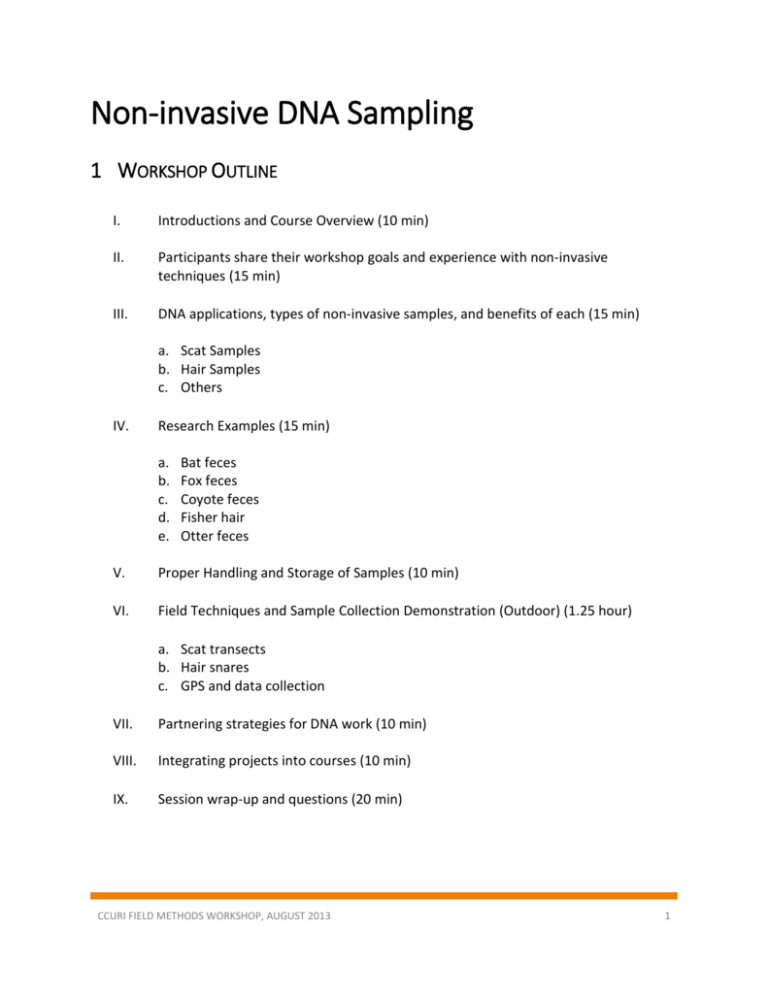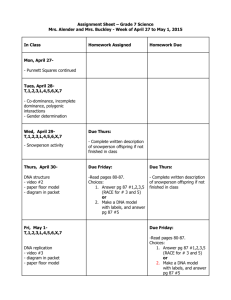Non-invasive_DNA_FINAL
advertisement

Non-invasive DNA Sampling 1 WORKSHOP OUTLINE I. Introductions and Course Overview (10 min) II. Participants share their workshop goals and experience with non-invasive techniques (15 min) III. DNA applications, types of non-invasive samples, and benefits of each (15 min) a. Scat Samples b. Hair Samples c. Others IV. Research Examples (15 min) a. b. c. d. e. Bat feces Fox feces Coyote feces Fisher hair Otter feces V. Proper Handling and Storage of Samples (10 min) VI. Field Techniques and Sample Collection Demonstration (Outdoor) (1.25 hour) a. Scat transects b. Hair snares c. GPS and data collection VII. Partnering strategies for DNA work (10 min) VIII. Integrating projects into courses (10 min) IX. Session wrap-up and questions (20 min) CCURI FIELD METHODS WORKSHOP, AUGUST 2013 1 2 NON-INVASIVE DNA APPLICATIONS The discovery of PCR and microsatellite primers has made non-invasive genetic sampling feasible by allowing small amounts of DNA to be amplified and used for identification. Mitochondrial DNA (mtDNA) is found in the mitochondria of a cell. It is unique in that it is only passed to offspring from mothers. Mitochondrial DNA is less variable within species, but variable between species, so it is used for species identification. Nuclear DNA is obtained from the nucleus of the cell and is used for individual identification or fine-scaled population genetics because it is more variable within a species. Non-invasive genetic analysis can be applied to a wide-range of wildlife research: Species Determination Sex Determination Paternity and relatedness Individual Identification Estimation of Population Size and Sex Ratio Management of Captive and Reintroduced Populations Diet assessment Hybridization and Inbreeding Wildlife Forensics Wildlife objectives related to ecology, management, and conservation: Abundance and relative abundance Occupancy Species distribution and range Sex-specific movements Turnover rates and survival Population genetics (study of the distribution and frequency of genes) Population size, gene flow, mating systems, genetic diversity, relationships between populations Spatial organization Landscape genetics CCURI FIELD METHODS WORKSHOP, AUGUST 2013 2 3 PROPER HANDLING AND STORAGE OF SAMPLES MOISTURE AND CONTAMINATION Moisture is the enemy of DNA samples, causing the DNA to degrade quickly! Keep samples as dry as possible by storing samples with a desiccant. Freezing is not a preferred method for wildlife samples. Contamination with human DNA is not a huge concern with wildlife samples unless you are working with primates. Microsatellite markers are species specific, and laboratories will use markers for the study species that will not be confused with human DNA. Therefore, wearing gloves during sample collection is not necessary to prevent contamination with human DNA, but should be used if contamination between samples may occur, and to protect the safety of field personnel. TYPES OF SAMPLES SCAT Prey items in scat can sometimes be detected instead of the species depositing the scat. Take surface rubs of fresh scat using absorbent swab (such as a Q-tip). Swabs can be stored in a breathable envelope, or in a tube of desiccant. HAIR DNA from hair is located in the hair follicles. Hair contains fewer chemical inhibitors than feces. When collecting hairs, use devices that pluck hairs, rather than removing hairs that have already shed (hair follicle may not be present). Store hairs in breathable (non-wax) envelopes. BONE AND ANTLERS Bones and antlers can be a good source of DNA if they do not decompose when drying. Bone and antler shavings can be stored dry in breathable paper envelopes. FEATHERS Feathers can be an excellent source of DNA. Store feathers in breathable envelopes. EGGSHELLS Eggshell membranes are a good source of DNA. Use cellophane tape on the outer side of the shell and tape to a breathable envelope. Do not tape on the membrane side due to the risk of trapping moisture. URINE AND SALIVA Urine and saliva are alternate sources of non-invasive DNA (urine in snow, scent posts). Check the current literature for handling and storage. LABELING SAMPLES All samples should have a unique identification code. Include an electronic file with field data associated with the sample (date of collection, location, etc.) when submitting samples to a laboratory. CCURI FIELD METHODS WORKSHOP, AUGUST 2013 3 4 NON-INVASIVE DNA RESOURCES BOOKS: Non-invasive survey methods for carnivores. 2008. Robert A. Long, Paula MacKay, William J. Zielinski, Justina C. Ray, editors. Island Press. 375 pp. LABORATORIES: Wildlife Genetics International, Inc. http://www.wildlifegenetics.ca P.O. Box 274 Nelson, BC V1L 5P9 877-352-3563 Northeast Wildlife DNA Laboratory http://www4.esu.edu/academics/departments/biology/dna/services.cfm East Stroudsburg University Jane Huffman, Director jhuffman@esu.edu (570) 422-7891 LAB EQUIPMENT SUPPLIERS: Qiagen – DNA Purification Kits http://www.qiagen.com Mo Bio – DNA Purification Kits http://www.mobio.com/ Life Technologies – Invitrogen Custom DNA Primers and DNA Purification Kits http://www.invitrogen.com/site/us/en/home/Products-and-Services/Product-Types/PrimersOligos-Nucleotides/invitrogen-custom-dna-oligos.html Eurofins Operon – PCR Ready Primers http://www.operon.com/products/pcr-primers/pcr-primer-overview.aspx?id=pcr GENETIC DATABASES: GenBank; National Center for Biotechnology Information CCURI FIELD METHODS WORKSHOP, AUGUST 2013 4






